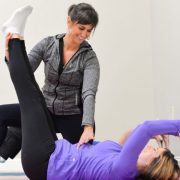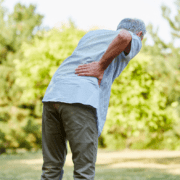Hip pain not going away? Three Reasons Why.
Hip pain is not nearly as common as knee or back pain, but it still impacts much of the population and it can be quite debilitating – especially when it doesn’t go away.
People routinely report hip pain in the side of their hip and in their groin. They may even complain that it radiates into their back and down their thigh. When this goes unresolved, it impacts your ability to walk, play golf, squat, bear weight on one leg, and even sleep through the night.
The big question, though, is why does it go away from some and persist for others?
If your hip pain isn’t going away – here are three reasons why:
1. You need a hip replacement
This is probably the most legitimate reason your hip pain isn’t going away. Your hip joint has become so arthritic and worn down that it’s time to get a new one.
But here’s the thing to keep in mind, whether or not you need a hip replacement should not be decided by your X-ray – it should be decided by your symptoms. Far too many people rely on the “bone-on-bone” diagnosis from imaging to be the determining factor. But there are hundreds of people walking around with fully functioning hips that have bone-on-bone and don’t need joint replacements yet.
When you need a new hip, the presentation is typically constant, unrelenting pain along with severely restricted mobility. In these instances, getting a new hip is going to be life changing and it should have a significant impact on your hip pain.
2. You’ve been mis-diagnosed
This is the most common reason why hip pain doesn’t go away. Just about everyone I see in my office with hip pain tells me they’ve been diagnosed with “hip bursitis”, when in reality, only 15% of women and 8% of women have true hip bursitis.
Hip bursitis occurs when you have inflammation of the bursa on the side of your hip. It’s typically caused by blunt trauma to your hip, or overuse/imbalance of the musculature there. It’s actually extremely easy to resolve so if your hip pain is persisting, this is likely not the reason.
The other common mis-diagnosis I see is that your hip problem is actually coming from your lower back. If you’ve got radiating pain into your thigh, you must always rule out that it’s not coming from your spine. Because if it is – and you don’t address it – your pain will never go away.
3. You’ve got the wrong treatment approach
If you don’t need a hip replacement, and you’ve got the right diagnosis, your hip pain should go away. If not, then we need to consider the treatment approach.
The most common mistake I see with hip pain treatment is implementing strengthening and stabilization exercises way too soon. The hip joint is one of the most mobile joints in our bodies. Because of that, it can be hard to detect when you’ve got some restrictions there. Having optimized mobility in your hip joint is paramount.
Without good, adequate mobility, your muscles will struggle to function as well as they could, and this can impact strength. I have a saying in my office: “mobility before stability”. And it’s for a good reason. If you don’t check mobility first, you risk strengthening and stabilizing around a joint that isn’t moving as well as it could. This could be a reason why your pain isn’t going away.
If you’ve got hip pain that isn’t going away, I hope this article has given you some food for thought.
Approximately 70-80% of all musculoskeletal problems, including hip pain, can be resolved naturally and without relying on pills, procedures, or surgery.
If you’re not having success with getting rid of your hip pain, then it’s important to question what you’re doing and consider that something has been missed. You deserve to live an active and mobile lifestyle doing all the activities you love.
Are you local to Portsmouth, NH?
Consider speaking to one of my specialists. Tell them about your hip pain and they’ll get you on a treatment plan right away – at the very least you’ll leave with some helpful tips moving forward.
Dr. Carrie Jose, Physical Therapist and Pilates expert, owns CJ Physical Therapy & Pilates in Portsmouth and writes for Seacoast Media Group. To get in touch, email her at [email protected].











